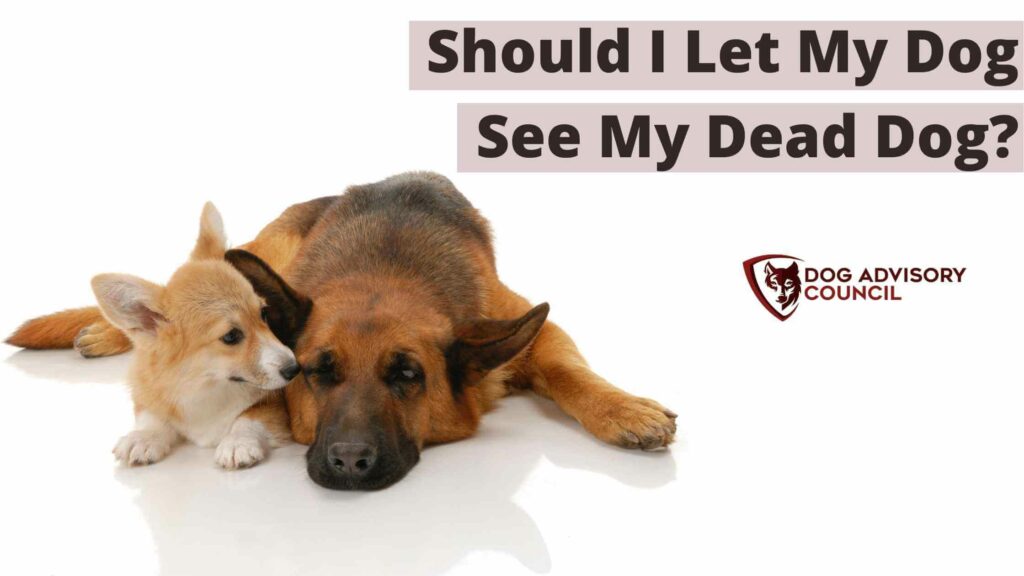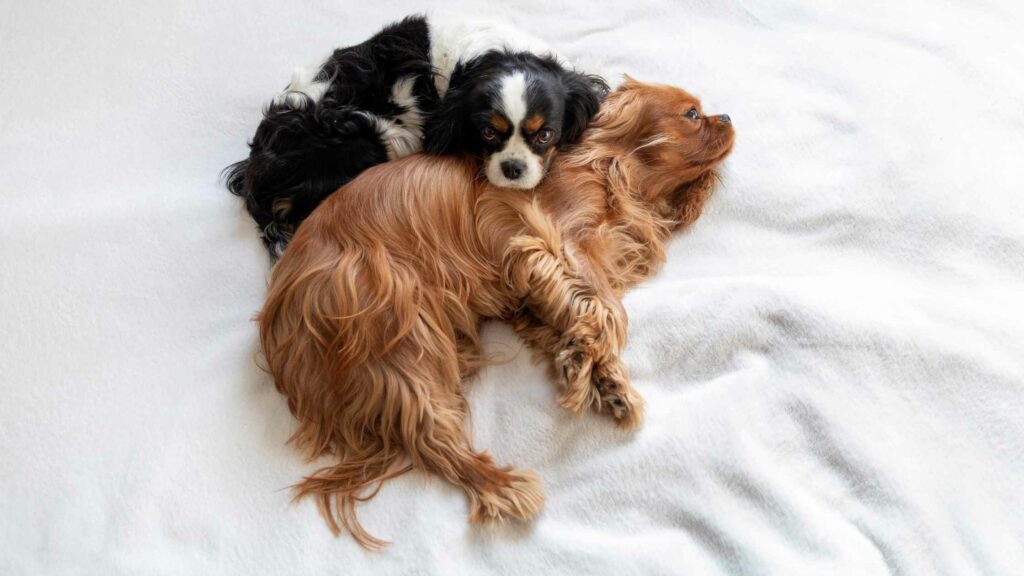
Losing one of your dogs is a complicated situation that brings about a lot of pain. It also brings a lot of pain to your surviving dog but also confusion. Can showing your dead dog’s body help with your surviving dog’s mourning? Here’s what you need to know.
You can safely let your surviving dog see your dead dog’s body if the deceased dog didn’t die from anything that could be harmful or contagious to your surviving dog. Dogs don’t understand death the way we do, so seeing the dead body of their companion can be essential for them to understand that something bad has happened.
Remember that dogs don’t have the same social cues about death and respect for the dead, so they may act aggressively or violently when they see their dead companion. Below is what you need to know to prepare yourself and your dog for this event.
Should I let my dog say goodbye to my dead dog?
Just like with any human family member, it’s a good idea to allow your dog to see its deceased family member if you can. This is especially a great idea if they are distressed about where their furry sibling is and why they aren’t around.
Dogs won’t say goodbye the same way humans will, but seeing and accessing the dead body will help them understand that something has happened and that it now means their furry companion is no longer going to be around.
This can be helpful for bonded pairs of pets that have spent their whole lives together. It also can help in situations where a dog’s death is sudden.
How do I know if showing the body is the right decision?
There is no wrong decision that you can make in this hard and painful emotional situation. You can choose to show or not show your dog’s dead body to your surviving dog solely based on what you think is best for them.
If your dog is confused and distressed, having them see the body can help ease that since it’ll help them understand that there has been a change. If your dog is already showing strong and emotional reactions to grief, showing them the body can intensify it.
You know your dog better than anyone, so you are the best one equipped to know what approach is going to be the most helpful for your surviving dog’s grief process. Ask a professional if you need it, as they can offer a logical point of view instead of an emotional one.
Do dogs know when another dog has died?
Dogs don’t understand the concept of death in a traditional sense no. They understand that something has happened, but the actual concept of death doesn’t make sense to dogs. This is similar to how dogs don’t understand that they, themselves, are dying.
Dogs understand that their furry companion is “different” but not dead. This means that they could react strangely to the dead body if you show it to them. They’re incapable of having the same social norms or respect for your dog’s dead body. If your dog acts “inappropriately” to a dead body, don’t chastise him — it’ll only increase his distress.
Can dogs sense a dead dog?
There is a myth that dogs can tell when a dog is dead or in the process of dying. Through their strong sense of smell and social cues like body language, they can understand that their friend is “changing” and that something is wrong. Most dogs will “understand” death as their fellow dog smelling different and no longer showing the same body language that they do.
Sometimes, your dog may even be confused about who this dog is. Since they smell different, it may seem like a different dog entirely, causing aggression and great distress in your surviving dog.
Do dogs smell death in other dogs?
Since death has a smell to it, as mentioned, experts agree that many dogs are about to smell death in other dogs. However, it often means that dogs understand that this is a different dog rather than their furry companion. It can increase confusion and distress as they try to understand what’s happening.
How do dogs deal with the death of another dog?
Dogs will grieve their lost friend just as a human would. They must do this in their own way, though you can definitely support them in their journey through the emotional roller coaster.
Many dogs will show intense anxiety in the early stages of grief. They don’t understand why their furry friend is no longer around and will frantically search for them, “calling” to them and otherwise trying to find them in your home. This can last for days or weeks at a time.
Your dog will also have a lot of confusion. Since you’re grieving, too, they’ll pick up on your anxiety and grief, which can confuse them. You may need to offer a lot of reassurance to your dog and help them understand that they and you are okay.
Adjusting to this new reality will be the best thing you can do for your dog’s sake. As they adjust, their emotional distress will ease, and, over time, they will forget about the loss. This can be very distressing for us, but it is a kindness to them.
What are the signs of a dog grieving?
So, what does a grieving dog actually look like? Grieving is a personal thing, just like in humans, but common signs are going to include:
- Crying and wining
- Searching the house for your lost dog
- Lack of appetite
- Lack of or excessive sleep
- Lethargy
- Signs of distress
Unlike humans, dogs won’t curb their symptoms of grief. It can be very upsetting for us to see our dogs in such emotional pain, but it’s essential to let them grieve in their own way. All we can do is support the process as much as we can.
When they come to you for comfort, offer it wholeheartedly and keep your energy as calm and warm as possible so that they can find solace with you in the hardest moments. You may find that it could be just what you need, too!

How do you help a grieving dog?
There are a lot of little things that you can do to help your dog grieve their loss. The most important thing is to take their grief seriously. They feel emotional pain as much as we do, and they’re confused about not understanding why this pain is there on top of the pain itself.
Keep your dog’s schedule as normal as possible. This normalcy will help them know what to do and when. This can offer relief rather than just emotional distress on top of a chaotic and unclear schedule. Even if your dog isn’t eating or sleeping, keep the schedule with amounts and times.
When your dog is distressed, try to offer them comfort. If they want to be loved, hugged, and cuddled, give it freely as often as possible. If they want to isolate themselves and cry privately, allow that, too. Be patient with this and focus on simply doing what you can.
Some dogs will have a sharp change of behavior as they grieve. From peeing in the house to acting aggressive for no reason, grief has its way of temporarily changing your dog. The emphasis here is on “temporarily,” of course. Reward only the positive behaviors you want to see, and avoid actively punishing the negative ones — it’ll only increase their distress.
The most important thing you can do, much like you would with a human in this situation, is to be patient. Your dog will have some intense feelings, and you’ll need to be at your dog’s side through the process. Stay patient, calm, and loving toward your dog. It’ll help more than anything else in the long run.
How long do dogs grieve the loss of another dog?
Just like humans, there is no set amount of time that a dog can grieve. They can show symptoms anywhere between 2 weeks-6 months after a loss. After that point, most will start to recover simply because their memories will fade, which will result in a fade in their emotions.
Can dogs get depressed when another dog dies?
Yes, dogs can get depressed when their companion dog dies. Anxiety fades into confusion which changes into depression, and they can suffer from that for months at a time. You’ll need to help your dog through it much like you would with classic grief. Your dog will come out of it in their own time.
Some owners will consider using anti-depressants, which can be a good idea if your dog is struggling with grief and is showing signs of distress long-term.
What happens when one dog in a bonded pair dies?
Losing their companion dog is one thing, but when a dog loses their bonded mate, it can be extremely distressing. A bonded mate who has lost their companion will react quickly and often very violently (emotionally speaking).
They’ll show intense waves of emotion and anxiety, often howling and crying as they wander inconsolably around the home looking for their mate. Their grief will be very intense and long-term, but it will pass just like it would with traditional relationships.
In situations with bonded pairs especially, a vet can help ease their discomfort by prescribing anti-depressants or pheromone treatments that will simply offer your pet some relief from the anguish. If your dog is showing depression symptoms or is inconsolable no matter what you do, this can be a kindness for them.
To conclude
In the case of a death not involving danger or contagions to your surviving dog, showing the body of a deceased dog can be helpful for your dog’s grieving process. It helps them understand that their companion is gone and will jumpstart the grief process.
Showing your surviving dog the dead body of your deceased dog can be a good idea to help them in their grief, but it isn’t required. Every pet parent must make that decision for them based on the bond their dogs shared and the reason for their dog’s death.
This should always be monitored by you since dogs can react almost violently to a dead body. They don’t have the same respect for the dead, either, which can be distressing for us. Consider this decision carefully and consult a professional if you need it!
